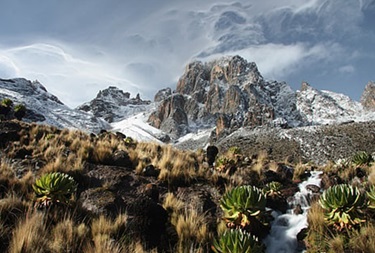(Preliminary exam:- Environment and Ecology and World Geography)
(Mains exam, General Studies Paper-3:- Conservation, Environmental Pollution and Degradation, Environmental Impact Assessment) |
Reference
According to a new study published in the Springer Nature journal, 49–55% of the vegetation cover of the Mount Kenya Forest Ecosystem (MKFE) is estimated to be destroyed by the year 2040.

About Mount Kenya
- Introduction: Mount Kenya is the highest mountain in Kenya, located in East Africa, which is the second highest mountain in Africa after Mount Kilimanjaro.
- Geographical features
- Volcanic origin: Mount Kenya is a dormant volcano that calmed down after an eruption about 3 million years ago.
- Glaciers: Earlier there were many glaciers on the peak of Mount Kenya, but due to climate change most of them have now disappeared.
- Ecosystem and Biodiversity: Mount Kenya has diverse climate zones that change with its altitude, giving rise to a variety of flora and fauna:-
- Major Fauna: Elephant, leopard, bear, wild boar, African buffalo.
- High altitude birds, such as Sunbird, Jackson Francolin.
- Endemic Species, such as Mount Kenya Highland Shrew
- Environmental Importance
- Major source of water resources for Kenya – supplying 40% of the country’s fresh water.
- Acts as a carbon sink.
- Important for climate regulation and rainfall
- Biodiversity Hotspot.
Key findings of recent studies
- Rising temperatures, increasing hydrological imbalances have caused Mount Kenya's glaciers to rapidly disappear, resulting in lower mountain forests, which depend on stable moisture conditions, becoming more vulnerable to drought stress and biomass loss.
- It serves as a major biodiversity hotspot and critical water source for Kenya supplying more than 40% of the country's freshwater.
- From 2002 to 2021, the country experienced a 14% reduction in its forest area, losing about 5,000 hectares annually.
- The primary factors driving the degradation of forest ecosystems are unregulated grazing, agricultural development, logging, charcoal production and poor forest management.
- The research findings highlight the combined effects of deforestation, agricultural development and climate-related stresses such as unpredictable rainfall and rising temperatures.
Impacts and Implications
- Water supply crisis → agriculture, drinking water and ecosystems affected.
- Loss of biodiversity.
- Decrease in carbon sink capacity.
- Adverse impact on livelihoods and food security of local communities.
Suggestions
- Stringent policies and implementation for forest conservation.
- Co-management of forests with participation of local communities.
- Reforestation and ecological restoration.
- Climate adaptation strategies such as water harvesting, drought-resilient agriculture.
- Satellite monitoring and data-based forest management decisions.


